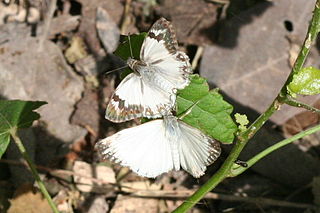Mallow or mallows may refer to:

Oenosandridae is a family of Australian noctuoid moths. Genera include:

Notodontidae is a family of moths with approximately 3,800 known species. The family was described by James Francis Stephens in 1829. Moths of this family are found in all parts of the world, but they are most concentrated in tropical areas, especially in the New World. The Thaumetopoeidae are sometimes included here as a subfamily.

Malvoideae is a botanical name at the rank of subfamily, which includes in the minimum the genus Malva. It was first used by Burnett in 1835, but was not much used until recently, where, within the framework of the APG System, which unites the families Malvaceae, Bombacaceae, Sterculiaceae and Tiliaceae of the Cronquist system, the aggregate family Malvaceae is divided into 9 subfamilies, including Malvoideae. The Malvoideae of Kubitzki and Bayer includes 4 tribes:-
Turk's cap is a common name for several plants and may refer to:

Malvaviscus palmanus is an understory tree of the Costa Rican cloud forest.

Hibisceae is a tribe of flowering plants in the mallow family Malvaceae, subfamily Malvoideae.

Heliopetes macaira, the Turk's-cap white-skipper , is a butterfly of the family Hesperiidae. It is found from southern Texas in North America, south through Central America to Paraguay.
Erbessa alea is a moth of the family Notodontidae first described by Herbert Druce in 1890. It is found in Ecuador.
Erbessa avara is a moth of the family Notodontidae first described by Herbert Druce in 1899. It is found in Ecuador.
Erbessa cuneiplaga is a moth of the family Notodontidae first described by Louis Beethoven Prout in 1918. It is found in Suriname, French Guiana and Brazil.
Erbessa dominula is a moth of the family Notodontidae first described by William Warren in 1909. It is found in Argentina, Uruguay and Brazil.
Erbessa prouti is a moth of the family Notodontidae first described by Hering in 1925. It is found in Brazil.
Erbessa salvini is a moth of the family Notodontidae first described by Cajetan and Rudolf Felder in 1874. It is found in Guatemala, Nicaragua, Costa Rica and Panama.
Erbessa tapajoza is a moth of the family Notodontidae first described by Paul Dognin in 1923. It is found in Brazil.

Tarache tetragona, the four-spotted bird dropping moth, is a moth of the family Noctuidae. It is found from southern Florida south through the Caribbean and from eastern Texas south through Mexico and most of Central America to Costa Rica.

Somera is a genus of moths of the family Notodontidae. The genus was erected by Francis Walker in 1855.
Nystaleinae is a subfamily of the moth family Notodontidae. The subfamily was described by William Trowbridge Merrifield Forbes in 1948.







